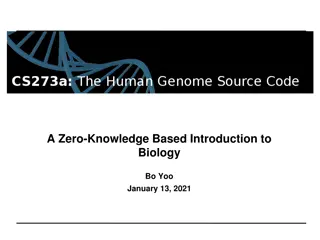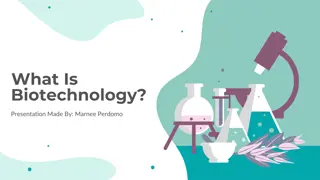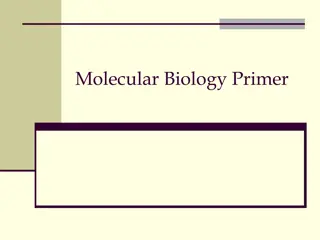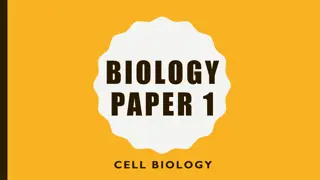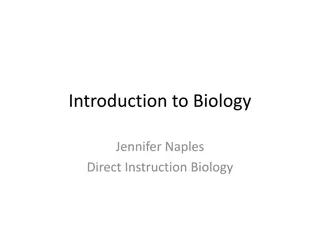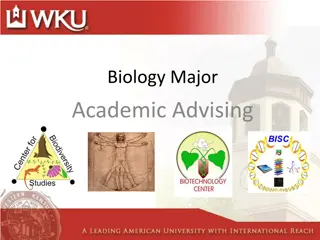Exploring Biology: An Overview of Key Concepts and Applications
Delve into the fundamental aspects of biology, from the structure and function of cells to the complexities of genetic inheritance and biotechnological advancements. Covering a wide range of topics including life processes, interactions in nature, and human impacts on the environment, this course provides a comprehensive introduction to the world of biology.
Download Presentation

Please find below an Image/Link to download the presentation.
The content on the website is provided AS IS for your information and personal use only. It may not be sold, licensed, or shared on other websites without obtaining consent from the author. Download presentation by click this link. If you encounter any issues during the download, it is possible that the publisher has removed the file from their server.
E N D
Presentation Transcript
SECTIONS / SCOPE OF G.E.S SYLLABUS Introduction to Biology Cells Life processes Diversity Interactions in nature Humans and their environment Genetics and evolution Biotechnology
NIG CONTENT KHAN ACADEMY (I) Characteristics of living thing. ii) Difference between plant and animals ii) Levels of organization of Life with examples The science of biology I) kingdom Monra:- Characteristics & examples ii) Kingdom Protista Characteristics & example Scientific methods Recognizing Living Things i) Kingdom fungi:- Characteristics & examples ii) Kingdom plantae :- Characteristics & examples iii) Kingdom Animalia :-
NIG CONTENT KHAN ACADEMY Basic characteristics of the cell - Structure of a cell - Introduction to cells - Cell theory Cell as a living unit of living organism The cell theory Prokaryotic and eukaryotic cells Fluid mosaic model of cell membrane; - Diffusion and osmosis - Types of solution - Hypotonic - -passive transport 2. CELL BIOLOGY Cell & Its Environment
NIG CONTENT KHAN ACADEMY CELL BIOLOGY -Extracellular structures and cell-cell junctions Properties and Functions of the Cell EXCRETION Definition of excretion Importance of excretion Difference between excretion, secretion and egestion. GROWTH Cell division Basis of Growth Regulation of growth by hormones Example of animal hormones IRRITABILITY Cell reaction to its environment, irritability as a basic characteristics of protoplasm. Types of responses with example: Nastic, tropic and taxis. Positive and negative responses MOVEMENT Definition and importance Reproduction
NIG CONTENT KHAN ACADEMY REPRODUCTION Reproduction Vegetative or artificial reproduction Reproduction and cell division TISSUE and SUPPORTING SYSTEM Types of Skeleton Vertebrate Skeleton Supporting Tissues in plants Body structure and homeostasis Tissues, organs, & organs system. The musculoskeletal system NUTRITION IN ANIMALS Food Substance Mode of Nutrition Mammalian Teeth Enzymes -Enzymes BASIC ECOLOGICAL CONCEPTS Components of an Ecosystem Population studies by Sampling method Ecological factors Functioning Ecosystem Trophic levels Ecology Trophic levels ENERGY TRANSFORMATION IN NATURE Energy loss in Ecosystem Laws of Thermodynamics Food Chain RELEVANCE OF BIOLOGY to AGRICULTURE Classification of Plants Effects of Agricultural activities on ecological system Pest and diseases of Agricultural importance Food Production and Storage Population growth and food supply
NIG CONTENT KHAN ACADEMY HABITAT Aquatic Habitat Terrestrial Habitat CLASSIFICATION OF PLANT Classification of plants into seed bearing and non seed bearing Classification of plants into cereals and legumes Classification into root crops, vegetables fruits, beverage and drug, oils latex (fibre) Types of digestive system (alimentary canal) Description and functions of the parts of alimentary tract Diagram of digestive tract of different groups of organisms. DIGESTIVE SYSTEM The digestive system
NIG CONTENT KHAN ACADEMY DIGESTIVE SYSTEM Modification of the feeding habits Feeding in Protozoa Feeding in mammals Modification of pest to effective digestive function of man, dogs, rabbits etc. Digestive system TRANSPORT SYSTEM Definition of transport system importance of diffusion osmosis materials for transport structures of arteries, veins, vascular bundles The circulatory system RESPIRATORY SYSTEM Types of respiratory system Mechanism of respiration in higher animals Respiratory System EXCRETORY SYSTEM Contractive vacuoles, flame cell, Malpighian tubules, kidneys, stomata and lenticels The Kidney Biogeochemical cycles NUTRIENT CYCLING IN NATURE Definition of nutrient cycling Representation and processes Importance of nutrient cycle to plants, animals and man
NIG CONTENT KHAN ACADEMY DECOMPOSITION IN NATURE Micro and macro decomposers Importance and roles of decomposers to man Concept of minimum and maximum of tolerance. ECOLOGICAL MANAGEMENT: TOLERANCE, ADAPTATION POLLUTION Atmospheric pollution Effect of air and noise CONSERVATION OF NATURAL RESOURCES Definition Needs or importance of conservation PEST AND DISEASES OF CROPS Definition of pest Classification of pest REPRODUCTIVE SYSTEM Fish And Reptiles Bird And Mammals Plants Reproduction Reproduction in mammal Plant Biology Plant POLLINATION IN PLANTS Definition and types Features of self-pollinated flower Agents of pollination Water, wind, insect animals.
NIG CONTENT KHAN ACADEMY REGULATION OF INTERNAL ENVIRONMENT Definition of homeostasis Organs and processes involved in homeostasis The structure, function and disease of kidney Human body systems Metabolism & thermoregulation THE LIVER The structure, function and diseases of liver Effects of liver diseases and remedies Processes and metabolism of deamination PLANT HORMONES Definition and types Functions of the plant hormones Effects axin on lateral development, leaf fall and initiation of adventurous roots ENDOCRINE GLANDS The endocrine glands and its hormones Functions of the endocrine glands Endocrine system THE SKIN Structure of mammalian skin Functions of mammalian kin Care of the mammalian skin NERVOUS COORDINATION Organization of the nervous system The central nervous system (CNS) Peripheral nervous system (PNS) The nervous system
NIG CONTENT KHAN ACADEMY THE CENTRAL NERVOUS SYSTEM (CNS) Position, structure and function of the brain The position, structure and function of the spinal cord THE PERIPHERAL NERVOUS SYSTEM (PNS) The flow chart representing the different part of the P.N.S The somatic NS Autonomic NS Sympathetic N.S SENSE ORGANS Organ of smell Organs of sight Ecology ECOLOGY OF POPULATION Succession Overcrowding BALANCE IN NATURE Factors affecting population Dynamic equilibrium in nature Family planning
REPRODUCTIVE SYSTEM AND REPRODUCTION IN HUMAN Parts and functions of reproductive part of human Structure of male sperm cell and female egg cell Fertilization DEVELOPMENT OF SEEDS AND FRUITS Process of development of Zygote in flowering plants pistil, stem, fertilization Germination of seeds Types of germination Conditions necessary for germination REPRODUCTIVE BEHAVIORS Courtship behaviors in animals pairing Animal behavior BIOLOGY OF HEREDITY Definition of heredity Transmission and expression of characters in organisms Variation Definition Chromosomes Location Mendels work in genetics Classical genetics Introduction to heredity VARIATION IN POPULATION Morphological variation
NIG CONTENT KHAN ACADEMY EVOLUTION Progressive change in structures and anatomy of organism Structural adaptation EVOLUTION THEORY OF EVOLUTION Theories of evolution (Darwins) Landmarks evolutionary law Modern evolution theory Evidence of evolution Evidence of evolution PRACTICAL ON FOOD TEST Test for presence of starch Test for presence of protein Test for the presence of simple reducing sugar. Test for a complex sugar. PRACTICAL OF FLOWERS AND FRUITS Arrangement of floral parts, placenta ion, types of cevary conditions necessary for photosynthesis





